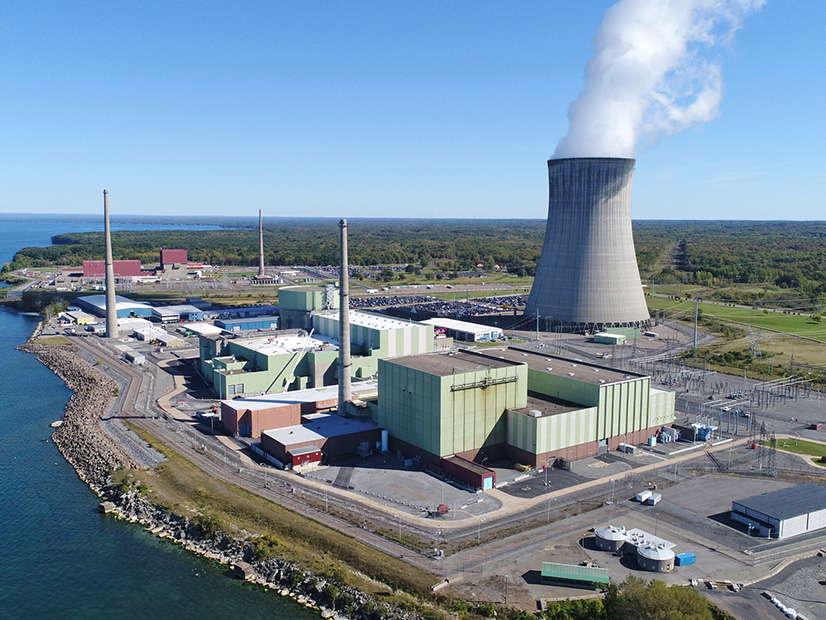Constellation Energy on Wednesday gave an update on the hydrogen production demonstration project at one of its nuclear plants in New York.
The first-in-the-nation production of “pink” hydrogen — generated through electrolysis powered by nuclear energy — began March 7 and is generating data about producing the cleaner-burning gas without generating emissions along the way.
The Nine Mile Point hydrogen project can generate up to 531 kg of hydrogen per day with a 1.5-MW draw: 1.25 MW for the electrolyzer, and 250 kW for its associated equipment.
The two nuclear reactors on site consume only about 80 kg in operation. What to do with the remaining capacity is the subject of a separate demonstration project backed by New York state that is expected to go online in 2025 and explore the potential of hydrogen fuel cells as a long-duration energy storage mechanism.
The electrolyzer project is scheduled to end Oct. 1, four years after it gained conditional approval. Constellation is looking at scaling up operations with the U.S. Department of Energy’s National Laboratories to demonstrate how electrolyzers might participate in power markets.
Constellation’s Bob Beaumont, who managed the installation of the electrolyzer and associated equipment at Nine Mile Point, gave an update Wednesday in a DOE webinar:
-
- Planning the project was a bowl of alphabet soup: NERC, NYISO, EPA, Nuclear Regulatory Commission and New York Department of Environmental Conservation regulations all had bearing on what was built.
- The project is running just shy of its $14.4 million budget.
- Weekly operations checks take four to five worker hours; quarterly maintenance about 20 worker hours; and annual maintenance about 20 worker hours.
- A quarter mile of cable was needed to power the electrolyzer, and it had to be buried several feet deep because of severe winters.
- The extreme cold — as low as -20 degrees Fahrenheit — caused valves to begin to leak and revealed a need for special sealing materials.
- The potential blast radii of the electrolyzer and the hydrogen storage tank in the event of a lightning strike or terrorist attack had to be evaluated because of the proximity of the two reactors; the system was placed out of the security zone and away from the safety systems. Also, the amount of hydrogen being stored on-site did not change, so a modification of NRC permits was not needed.
- The system was designed to automatically shut down and vent itself if it is hit by seiche waves off Lake Ontario during a storm or after an earthquake.
- The process draws about 2 gallons of water per minute from the local municipal water system, runs it through consumer-grade softeners and carbon filters; and passes it through a reverse osmosis filter and a set of resin filters to reduce its conductivity to the right level; too much conductivity leaves impurities on the membranes, too little thwarts the electrolyzer.
Future Fuel
Hydrogen, which burns without producing greenhouse gas emissions, is potentially a key tool in fighting climate change. It could serve as a form of energy storage and is viewed as an alternative power source for industries and applications that otherwise would be hard to decarbonize.
But the cost of production currently is a barrier to wider use. DOE made reducing that cost by 80%, to $1/kg, the central goal of the first of its Energy Earthshots in 2021.
Interest is keen in green hydrogen — derived from renewable resources — because producing greenhouse emissions to generate hydrogen limits the net benefit of burning that hydrogen instead of fossil fuel.
Pink hydrogen is produced with emissions-free nuclear power and, in some processes, with the excess heat generated by nuclear fission.
Beyond hydrogen’s potential role in the clean energy transition, operators of boiling-water reactors such as the two at Nine Mile Point use it steadily to prevent corrosion inside the reactors and as a coolant for the rotors on the generators.
Constellation partnered on the Nine Mile Point demonstration project with Nel Hydrogen, manufacturer of the electrolyzer membranes, and the National Renewable Energy, Argonne and Idaho national laboratories.
DOE hydrogen demonstration projects are underway at three other nuclear power stations nationwide.


